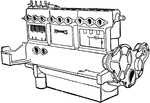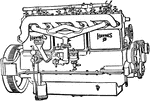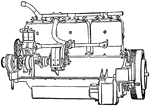Clipart tagged: ‘car parts’

Building an Automobile, Step 01: Crankcase
"Crankcase showing bearings. The heart of the automobile is the engine. It is built around the crankcase,…

Building an Automobile, Step 02: Crank-Shaft and Fly-Wheel
"Crankcase with crank-shaft and fly-wheel added. The crankshaft serves the same purpose in an automobile…

Building an Automobile, Step 03: Cylinders Showing Piston and Crankshaft
"Cylinders showing piston in place and connected to crankshaft. Gasoline vapor is exploded in the cylinders.…

Building an Automobile, Step 04: Cogwheels
"The gears or 'cogwheels' are for running the fan, the pump and other parts." -Bodmer, 1917

Building an Automobile, Step 05: Cylinder Added to Crankcase
"Cylinder added to crankcase. The cylinders are next bolted down to the crankcase, the pistons and crankshaft…

Building an Automobile, Step 06: Reservoir Added
"An oil pan or reservoir is attached to the bottom of the crankcase to hold oil for the engine." -Bodmer,…

Building an Automobile, Step 07: Carburetor
"The carburetor furnishes the gasoline vapor for the cylinders. It is connected to the engine by a crooked…

Building an Automobile, Step 08: Oil Pump and Filler
"Oil pump and filler added to motor. Oil is poured in the spout which is at the left of the carburetor.…

Building an Automobile, Step 09: Electric Generator
"The electric generator makes electricity to be used for starting the engine and lighting the car."…

Building an Automobile, Step 10: Magneto
"The magneto gives an electric spark, which explodes the gasoline in the cylinders. The water pump keeps…

Building an Automobile, Step 11: Motor
"An electric motor starts the engine by turning the fly-wheel. This makes it unnecessary to get out…

Building an Automobile, Step 12: Transmission
"The transmission is added. The transmission makes it possible to reverse the car. It also enables the…
Building an Automobile, Step 13: Frame
"Double-drop pressed steel frame. The frame on which the car is built." -Bodmer, 1917
Building an Automobile, Step 14: Elliptic Springs
"Addition of semi-elliptic and three-fourths-elliptic springs to frame. Large springs are placed at…
Building an Automobile, Step 16: Rear Axle
"Showing addition of full-floating rear axle." -Bodmer, 1917

Building an Automobile, Step 17: Engine and Transmission Attached to the Frame
"Completed engine and transmission is next fastened to the frame and connected to the rear axle by the…
Building an Automobile, Step 18: Gasoline Tank
"Showing addition of gasoline tank and gas lead to carburetor." -Bodmer, 1917

Building an Automobile, Step 19: Steering Gear
"Showing how steering gear is connected." -Bodmer, 1917

Building an Automobile, Step 21: Radiator
"Completed chassis with radiator added. The water which keeps the engine from getting too hot is pumped…

Automobile Starter
An automobile starter is an electric motor which uses electrical energy to produce mechanical energy,…


